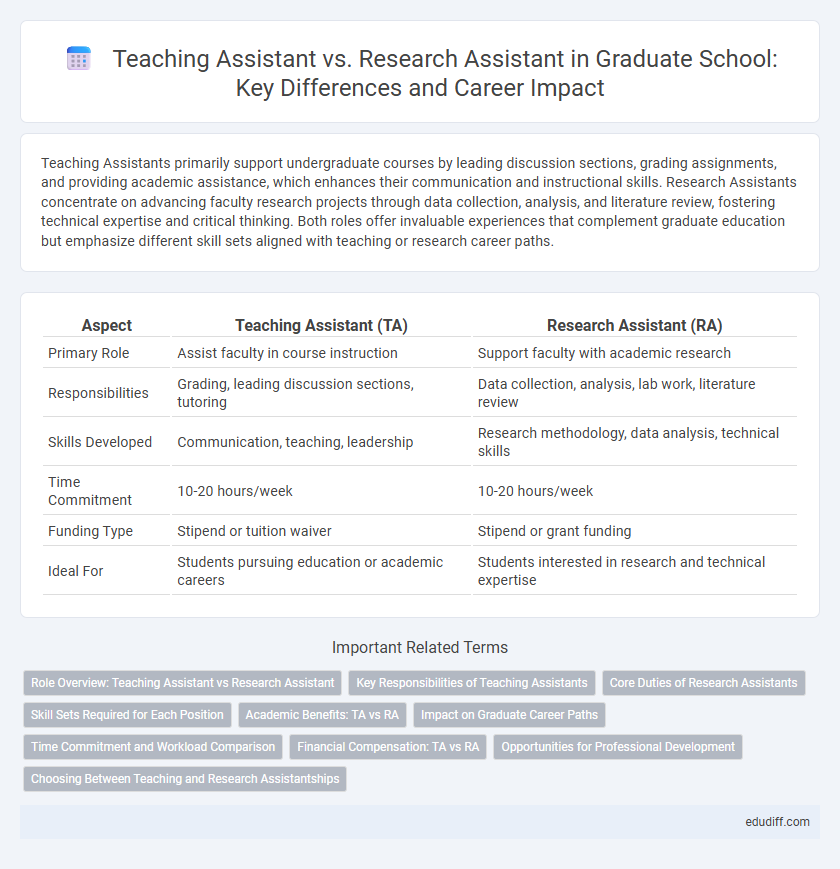Teaching Assistants primarily support undergraduate courses by leading discussion sections, grading assignments, and providing academic assistance, which enhances their communication and instructional skills. Research Assistants concentrate on advancing faculty research projects through data collection, analysis, and literature review, fostering technical expertise and critical thinking. Both roles offer invaluable experiences that complement graduate education but emphasize different skill sets aligned with teaching or research career paths.
Table of Comparison
| Aspect | Teaching Assistant (TA) | Research Assistant (RA) |
|---|---|---|
| Primary Role | Assist faculty in course instruction | Support faculty with academic research |
| Responsibilities | Grading, leading discussion sections, tutoring | Data collection, analysis, lab work, literature review |
| Skills Developed | Communication, teaching, leadership | Research methodology, data analysis, technical skills |
| Time Commitment | 10-20 hours/week | 10-20 hours/week |
| Funding Type | Stipend or tuition waiver | Stipend or grant funding |
| Ideal For | Students pursuing education or academic careers | Students interested in research and technical expertise |
Role Overview: Teaching Assistant vs Research Assistant
Teaching Assistants (TAs) support course instruction by leading discussion sections, grading assignments, and assisting students with class material to enhance learning outcomes. Research Assistants (RAs) contribute to academic research projects through data collection, analysis, and literature reviews, helping advance scholarly knowledge in their field. Both roles develop critical skills, but TAs focus on pedagogical support while RAs emphasize research contributions.
Key Responsibilities of Teaching Assistants
Teaching Assistants primarily support course instruction by leading discussion sections, grading assignments, and providing feedback to students. They facilitate student learning experiences and manage classroom activities under the supervision of a faculty member. Their role is distinct from Research Assistants, whose responsibilities are centered around conducting experiments, data analysis, and contributing to academic publications.
Core Duties of Research Assistants
Research Assistants primarily focus on conducting experiments, collecting and analyzing data, and contributing to the preparation of research reports and publications under faculty supervision. Their duties often involve literature reviews, managing lab equipment, and assisting with grant proposals, which directly support the advancement of academic research projects. This role requires strong analytical skills, attention to detail, and proficiency in relevant research methodologies and software tools.
Skill Sets Required for Each Position
Teaching Assistants require strong communication and organizational skills to effectively manage classrooms, facilitate discussions, and support student learning. Research Assistants need advanced analytical abilities, proficiency in data collection and analysis, and expertise in relevant research methodologies. Both roles demand attention to detail and time management, but Teaching Assistants focus more on interpersonal skills while Research Assistants emphasize technical and investigative competencies.
Academic Benefits: TA vs RA
Teaching Assistants (TAs) gain valuable experience in communication, leadership, and curriculum development through direct student interaction and grading responsibilities, enhancing academic and pedagogical skills. Research Assistants (RAs) contribute to cutting-edge projects, fostering specialized expertise, critical thinking, and proficiency in research methodologies that bolster academic credentials. Both roles improve graduate teaching portfolios but differ: TAs excel in instruction-related competencies while RAs strengthen research-oriented academic profiles.
Impact on Graduate Career Paths
Teaching Assistants develop strong communication and leadership skills by managing classroom instruction and student interactions, which enhances career prospects in academia and education-focused roles. Research Assistants gain hands-on experience in experimental design, data analysis, and scholarly research, positioning them for careers in research-intensive fields and advanced graduate studies. Both roles contribute uniquely to a graduate student's professional development, with TAships emphasizing pedagogical expertise and RAships fostering specialized knowledge and technical skills.
Time Commitment and Workload Comparison
Teaching assistants typically dedicate 10 to 20 hours per week managing grading, leading discussion sections, and holding office hours, which demands consistent interaction with students and preparation. Research assistants often work 15 to 25 hours weekly engaged in data collection, experiment design, and literature review, with workload peaking during project deadlines. The variability in time commitment is influenced by the academic calendar for teaching assistants and project phases for research assistants, making workload intensity context-dependent.
Financial Compensation: TA vs RA
Teaching Assistants (TAs) typically receive stipends or hourly wages based on teaching responsibilities, often including tuition remission and health benefits. Research Assistants (RAs) are generally funded through research grants, with compensation levels varying widely depending on the funding source and project budget. Financially, RAs may receive higher stipends when involved in well-funded projects, while TAs offer more consistent compensation tied to academic semesters.
Opportunities for Professional Development
Teaching Assistants gain valuable experience in public speaking, curriculum design, and classroom management, which enhances their communication and leadership skills. Research Assistants develop strong analytical abilities, project management expertise, and technical proficiency in their specialized field, contributing to their academic and research credentials. Both roles offer mentorship opportunities and networking connections that are essential for career advancement in academia and industry.
Choosing Between Teaching and Research Assistantships
Choosing between teaching and research assistantships depends on career goals and skill development priorities. Teaching assistantships enhance communication, leadership, and instructional skills by working directly with students and faculty in academic settings. Research assistantships provide hands-on experience with data analysis, experimental design, and scholarly publishing, preparing graduates for academic or industry research roles.
Teaching Assistant vs Research Assistant Infographic

 edudiff.com
edudiff.com